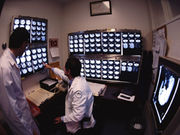Authors say diagnostic laparoscopy not needed for inguinal testes or nubbins
WEDNESDAY, April 20, 2016 (HealthDay News) — Combined diffusion-weighted imaging (DWI) and magnetic resonance imaging (MRI) show a greater performance compared to conventional MRI alone for identification of non-palpable undescended testes (UDTs), according to a study published online April 6 in the Journal of Medical Imaging and Radiation Oncology.
Sally Emad-Eldin, M.D., from Cairo University Hospitals, and colleagues evaluated the diagnostic performance of combined DWI and conventional MRI, including fat-suppression T2WI, for identification and localization of non-palpable UDTs in 40 consecutive patients with 47 non-palpable undescended testes (33 unilateral cases and seven bilateral cases; mean age 7.5 years).
The researchers found that the final diagnoses of the location of UDTs based on laparoscopy findings were: intra-canalicular (18 cases), low intra-abdominal (six cases), and high intra-abdominal (five cases). There were 18 cases of absent or vanishing testes. Combined DWI and conventional MRI had a diagnostic accuracy, sensitivity, and specificity of 95.7, 93.5, and 100 percent, respectively.
“Based on our findings, we can obviate the need for diagnostic laparoscopy in patients who had preoperative detection of inguinal testes or nubbins,” the authors write.
Copyright © 2016 HealthDay. All rights reserved.








